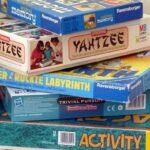Little did we know that board games provide us with a participative method of developing numeric and language literacy among dyslexic children. These are nothing but fun techniques of teaching dyslexic children the skills of planning, thinking, and coordinating body and mind to obtain learning goals.
Great Games for Students With Dyslexia

When these dyslexic children start learning actions of analyzing, sorting, challenging, or helping each other, they start adopting fluency and speed in writing and reading while also boosting the process of acquiring social intelligence.
What is Dyslexia?
If you don’t know what dyslexia is, it is a learning disorder that occurs in children and that has a detrimental effect on your ability to spell, write, read and speak.
Kids who suffer from dyslexia are usually hardworking and smart but they find difficulty in connecting letters with the sound that the letters make when spoken.
Kids with dyslexia usually have normal vision and are as smart as others without dyslexia. However, they have to constantly fight with themselves as they take more time to read and write.
Using board games for dyslexic children – What are the benefits?
Board games usually offer playful techniques for developing basic writing, reading, and math solving skills in dyslexic children. Here are few ways in which board games can help kids suffering from dyslexia.
- Board games help in negating the negative reaction among dyslexic children who find it difficult to write and read through traditional means.
- They help in giving instructions in such a manner that students can comprehend easily and enjoy the process.
- They motivate students to involve themselves more in the learning process and this helps in better participation.
List of the best board games for dyslexics
AZUL
One of the most easily accessible board games for dyslexics on this list is Azul. In this game called Azul, each player plays as a professional who tries to build the tiles (patterned) to decorate the home of the kind.
The main aim of the game is to make patterns and make sure you achieve the right tiles for completing the given patterns. This is a game that is played entirely with visual elements rather than textual. You won’t have to struggle to read the small texts on cards or the thick rulebooks.
Pros:
- Ideal for all ages from eight and above.
- Easy to adapt the rules of the game.
- The game looks awesome as you play it.
- Supports 2-4 players.
- Visually motivating.
Cons:
- The scoring system is a bit complicated to understand.
BLOKUS
Just as Azul, Blokus is also a game that is all about designing patterns. The main goal of this game is to fit in the color that you’ve chosen wherever you can.
Each player has to get 21 of the colored pieces that are placed somewhere on the board. But you have to make sure that each piece that you place touches one more piece of the same color and this should happen only on the corners.
The rules are pretty simple and hence none will struggle while playing Blokus. It’s a perfect game for the entire family.
Pros:
- Games can be played fast.
- Easy gameplay.
- You can learn the tricks of the game within a minute.
- Great for the whole family.
- Board looks colorful as you play.
Cons:
- A simple interface might not appeal to someone who prefers a sophisticated experience.
CARCASSONE
Their rulebook has been redone freshly so that the game could be easily understood by the dyslexic players who are also beginners.
Carcassone is a game that is exceptionally easy to learn as the rules of the game are too straightforward for novices. However, the strategies are multiple to appeal to the veterans of board games.
The goal in this game is pretty clear – claim as many features on the board and earn as many points as you can!
Each player, one by one, will take turns to draw tiles and place them on the board and each tile could have several features on it. There are features like roads, cities, and farms.
When a player has to claim a landmark, he has to set one of the Meeples (mini-figures of people) down before anyone else. Well, this may sound too easy but there is a big strategy involved here.
Pros:
- Ideal for beginners but strategic for veteran players.
- No need to read cards packed with text as their rulebook is easily readable.
- Boards will have a different look each time as the tiles are drawn randomly.
- There are tons of tutorials to refer to when you don’t wish to read the rulebook.
Cons:
- With tiles drawn randomly, the game can often come down to luck if not on strategy.
MYSTERIUM
For anyone who is looking for a creepy and mature experience, experts recommend Mysterium. This game is not full of rules and hence it is easy for someone suffering from dyslexia to play this game in total comfort.
You will need a minimum of two players to play this game. Someone has to be the ghost and the other players have to be investigators. The goal of the game is to discover how the ghost is killed and the ghost is allowed to utilize picture cards to give cues to other players.
The catch here is that these picture cards are dream-like and bizarre. The cards won’t be easy to interpret by the investigator and here lies the ultimate challenge.
Pros:
- Interesting paranormal story and theme.
- High replay value as the mystery fact is different each time you play.
- Can be played with a minimum of 2 and a maximum of 7 players.
- Has the most stunning artwork that we’ve seen in board games.
Cons:
- It is recommended to play with different people as playing time and again with the same people will develop a strange sense of code with the pictures. This will turn the game into too easy.
AGGRAVATION
Doesn’t this game sound like you should never wish to play this game with such a strange name, Aggravation? But you shouldn’t just judge the book by its cover as this game is equally maddening as its name.
Each person who plays should take one color and the corresponding side of the board which has that color.
Keeping the colored marbles at the right place, players have to race each other all over the board. The dangerous part of the game is in the aggravation, where an opponent captures the marble on your way.
Pros:
- It is a sturdy board and hence you needn’t worry about it ripping easily.
- Can play with up to 6 members.
- Rules are super-easy to understand.
- Ideal for the entire family.
Cons:
- Bumping the board may cause the marbles to roll out of the actual place, thereby reducing the effect of the game.
JENGA
When you ask someone about board games, Jenga is certainly not the game that comes to your mind. Nevertheless, we’re still including it as it is a classic game that works amazingly for a person suffering from dyslexia.
You don’t have to read any card filled with text as the game is extremely easy. On stacking all the Jenga blocks on a tower, the players have to remove the blocks without knocking the entire tower. If you’re the last person to pull a block without knocking the tower, you’re the winner.
Pros:
- A classic game that all know how to play.
- Can be played with any number of members.
- Takes a very short time to set up and clean up.
- Ideal for all age groups.
Cons:
- The box is a bit too heavy and hence it doesn’t hold the blocks in a shape of a tower when you put them away.
WOOD CHECKERS AND TIC TAC TOE
You must have heard the name of this time-honored classic! What better way than bringing this to your tabletop? When you get this set, you will get not only one but two games, Tic Tac Toe, and Checkers.
Both are super-easy games and the players won’t take too much time to learn them. Neither are they complicated nor are there tough rulebooks to read through. Both the games can be played on a strong solid board made of wood.
Pros:
- Has two sets of games in one set.
- Both Tic Tac Toe and Checkers can be learned in few minutes.
- The board is made of solid and sturdy wood.
- Ideally enjoyed by the whole family regardless of age.
Cons:
- Both games are too easy for the seasoned and experienced board game players.
- Few are of the opinion that the board is too slippery at times.
Conclusion
For dyslexic people, letters and numbers are often interposed. It gets tough for them to read long paragraphs and speak at length. However, that doesn’t mean it is impossible for them to do these.
Most dyslexics get habituated to cope with their condition and hence they go about their normal daily lives. Engage them in the above-mentioned board games to improve their reading and thinking abilities.
Join 25,000+ smart readers—don’t miss out!









